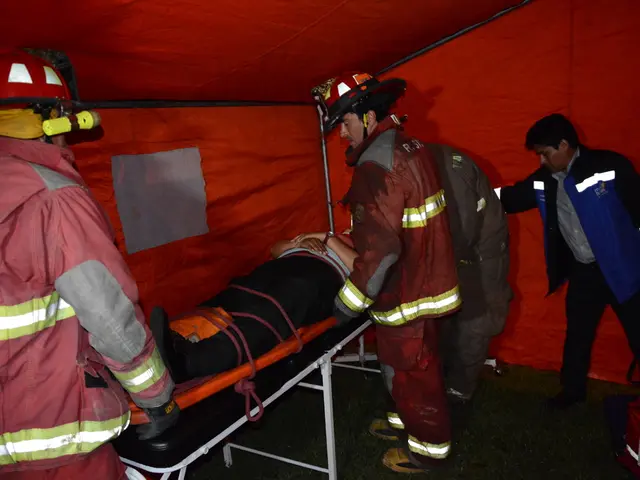Distinguishing age spots from skin cancer: Recognizing the essential variations
Age spots, also known as liver spots or solar lentigines, are harmless dark spots that can appear on the skin as we age. While they might look similar to certain types of skin cancer, they are nothing to worry about and don't require treatment.
Now, let's clarify the differences between age spots and skin cancer. You see, both conditions can manifest on areas of the skin that have been exposed to the sun, such as the face, hands, or shoulders. However, while age spots are smooth and flat, skin cancer can exhibit irregular features like asymmetrical shapes, uneven or blurry borders, multiple colors within the same spot, and other alarming signs. You should be extra cautious if you notice a mole changing in size, shape, or color.
Now, let's break it down:
Age Spots
Age spots occur due to the body producing excess melanin to protect the skin from sun damage. They generally appear on light skin and from middle age onward. Age spots are usually flat, smooth, and yellow, brown, or gray. They have clear borders and can vary in size.
Skin Cancer
Skin cancer is a type of cancer that happens when UV radiation or other factors damage skin cells. This leads to accelerated cell growth and, later, cancerous cells that can spread to other parts of the body. The most common types of skin cancer are basal cell carcinoma, squamous cell carcinoma, and melanoma. Actinic keratosis is another precancerous growth that can resemble age spots.
Now, the million-dollar question: can age spots turn into cancer? Nope, age spots cannot. However, actinic keratosis can develop into skin cancer if left untreated. So, it's essential to pay attention to new or changing marks on the skin and consult a healthcare professional if any signs of skin cancer or actinic keratosis appear.
When it comes to symptoms, age spots and skin cancer show some differences:
Age Spot Symptoms
- Flat and smooth
- Yellow, brown, or gray
- Defined with clear borders
- Between a few millimeters or centimeters in size
- On sun-exposed areas, such as the face, hands, shoulders, feet, arms, and back
Skin Cancer Symptoms
- Asymmetrical shape
- Irregular, blurred, or ragged edges
- Changing size, color, or shape
- Multiple colors on the same spot
- Raised, red patches
- Pale or yellow firm patches, similar to scars
- Pain, itching, oozing, or bleeding
- Crusty or scaly patches
- Raised edges that lower in the middle
It's crucial to contact a doctor if you notice any skin symptoms that are unusual for you, especially if the mark changes in color, shape, size, or location, or doesn't heal within four weeks.
To diagnose age spots or skin cancer, a doctor or dermatologist will perform a physical examination. If they're unsure, they might perform a skin biopsy to test for other conditions, such as skin cancer or actinic keratosis.
Treatment options for age spots include creams, lotions, and cosmetic procedures like laser therapy, chemical peels, cryosurgery, microdermabrasion, and bleaching creams. If diagnosed with skin cancer, prompt medical intervention is necessary for prompt treatment to prevent spread and improve prognosis. Possible treatments include surgical removal, chemotherapy, radiation therapy, targeted therapy, and immunotherapy.
In summary, while age spots and skin cancer can look similar, there are ways to tell them apart. Consult a healthcare professional if you spot any skin changes, and remember that diagnosing skin cancer early can help make treatment more straightforward. Age spots are harmless, but you can choose to have cosmetic treatments to reduce their appearance if desired. Keep the sun protection game strong!
- Seniors often develop age spots, which are harmless dark spots on the skin caused by sun damage and the body's excess melanin production.
- While age spots can resemble some types of skin cancer, they are generally flat, smooth, and have clear borders, unlike cancerous spots that can exhibit irregularities.
- On the other hand, skin cancer, such as basal cell carcinoma, squamous cell carcinoma, or melanoma, can manifest with irregular shapes, uneven or blurry borders, multiple colors within the same spot, and other concerning symptoms.
- Actinic keratosis, a precancerous growth, can resemble age spots but can develop into skin cancer if left untreated.
- Cancer symptoms may include changing size, shape, or color of a mole, raised, red patches, pale or yellow firm patches, pain, itching, oozing, or bleeding, and crusty or scaly patches.
- If you notice unusual skin symptoms, such as an irregularly shaped spot that doesn't heal within four weeks, it's essential to consult a healthcare professional for a proper diagnosis and potential treatment.
- A dermatologist will typically perform a physical examination to diagnose age spots or skin cancer and may perform a skin biopsy if unsure.
- Treatment for age spots includes various cosmetic procedures and creams, while prompt medical intervention is necessary for skin cancer to prevent spread and improve prognosis.








